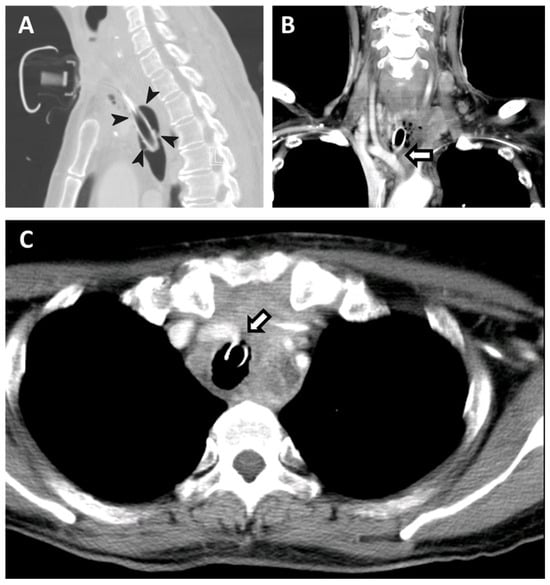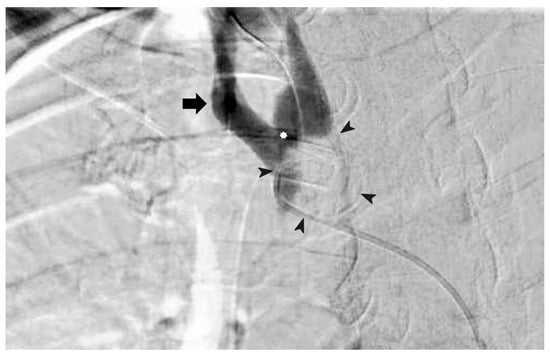Abstract
We report an angiographic image of a 58-year-old woman with profuse bleeding from a tracheo-innominate artery fistula. It may not have been possible to obtain this valuable image if adequate initial resuscitation and an over-inflated tracheostomy tube cuff had not been administered to stop bleeding during an emergency.
A 58-year-old woman presented to our hospital with profuse bleeding from a deflated cuff tracheal stoma. She had stage IVB anaplastic thyroid carcinoma with upper airway obstruction and had undergone tracheostomy 3 months prior to this admission. Pembrolizumab 100 mg (2 mg/kg) had been given every 3 weeks and she had received a radiation dose of 75 Gy in 25 fractions over the neck tumor. The cuff of a tracheostomy tube was over-inflated to temporarily stop bleeding in an emergency. In suspicion of a tracheo-innominate artery fistula, she received computed tomography angiography after initial stabilization (Figure 1 and Figure 2).
Besides adequate initial resuscitation, over-inflating the cuff of a tracheostomy tube may be an effective technique to temporarily control bleeding from tracheo-innominate artery fistulae [,,,,]. This case demonstrated the reliability of computed tomography angiography as an imaging modality for confirmation.
Supplementary Materials
The following supporting information can be downloaded at: https://www.mdpi.com/article/10.3390/diagnostics14020223/s1, Figure S1: Angiography and intraoperative picture of surgical procedure.
Author Contributions
Conceptualization, W.-R.T. and Y.-Y.C.; investigation, Y.-C.H. and W.-R.T.; writing—original draft preparation, Y.-C.H. and W.-R.T.; writing—review and editing, Y.-Y.C.; visualization, W.-R.T.; supervision, Y.-Y.C. All authors have read and agreed to the published version of the manuscript.
Funding
This research received no external funding.
Institutional Review Board Statement
The study was conducted in accordance with the Declaration of Helsinki and was approved by National Cheng Kung University Hospital Institutional Review Board on 2023.12.20 (IRB No. B-EC-112-034; Date: 2023.12.20).
Informed Consent Statement
Written informed consent for the publication of details and images was obtained from the patient’s husband.
Conflicts of Interest
The authors declare no conflicts of interest.
References
- Jones, J.W.; Reynolds, M.; Hewitt, R.L.; Drapanas, T. Tracheo-innominate artery erosion: Successful surgical management of a devastating complication. Ann. Surg. 1976, 184, 194–204. [Google Scholar] [CrossRef] [PubMed]
- Ramadan, H.H.; El Solh, A.A. An update on otolaryngology in critical care. Am. J. Respir. Crit. Care Med. 2004, 169, 1273–1277. [Google Scholar] [CrossRef] [PubMed]
- Lin, C.Y.; Lee, K.C.; Yang, M.S.; Lieu, F.K. Tracheoinnominate artery fistula after percutaneous tracheostomy. J. Formos. Med. Assoc. 2015, 114, 88–89. [Google Scholar] [CrossRef] [PubMed]
- Menen, R.S.; Pak, J.J.; Dowell, M.A.; Patel, A.R.; Ashiku, S.K.; Velotta, J.B. Treatment of Tracheoinnominate Fistula with Ligation of the Innominate Artery: A Case Report. Perm. J. 2016, 20, 15–166. [Google Scholar] [CrossRef] [PubMed]
- Khanafer, A.; Hellstern, V.; Meissner, H.; Harmening, C.; Schneider, K.; Henkes, H. Tracheoinnominate fistula: Acute bleeding and hypovolemic shock due to a trachea-innominate artery fistula after long-term tracheostomy, treated with a stent-graft. CVIR Endovasc. 2021, 4, 30. [Google Scholar] [CrossRef] [PubMed]
Disclaimer/Publisher’s Note: The statements, opinions and data contained in all publications are solely those of the individual author(s) and contributor(s) and not of MDPI and/or the editor(s). MDPI and/or the editor(s) disclaim responsibility for any injury to people or property resulting from any ideas, methods, instructions or products referred to in the content. |
© 2024 by the authors. Licensee MDPI, Basel, Switzerland. This article is an open access article distributed under the terms and conditions of the Creative Commons Attribution (CC BY) license (https://creativecommons.org/licenses/by/4.0/).

